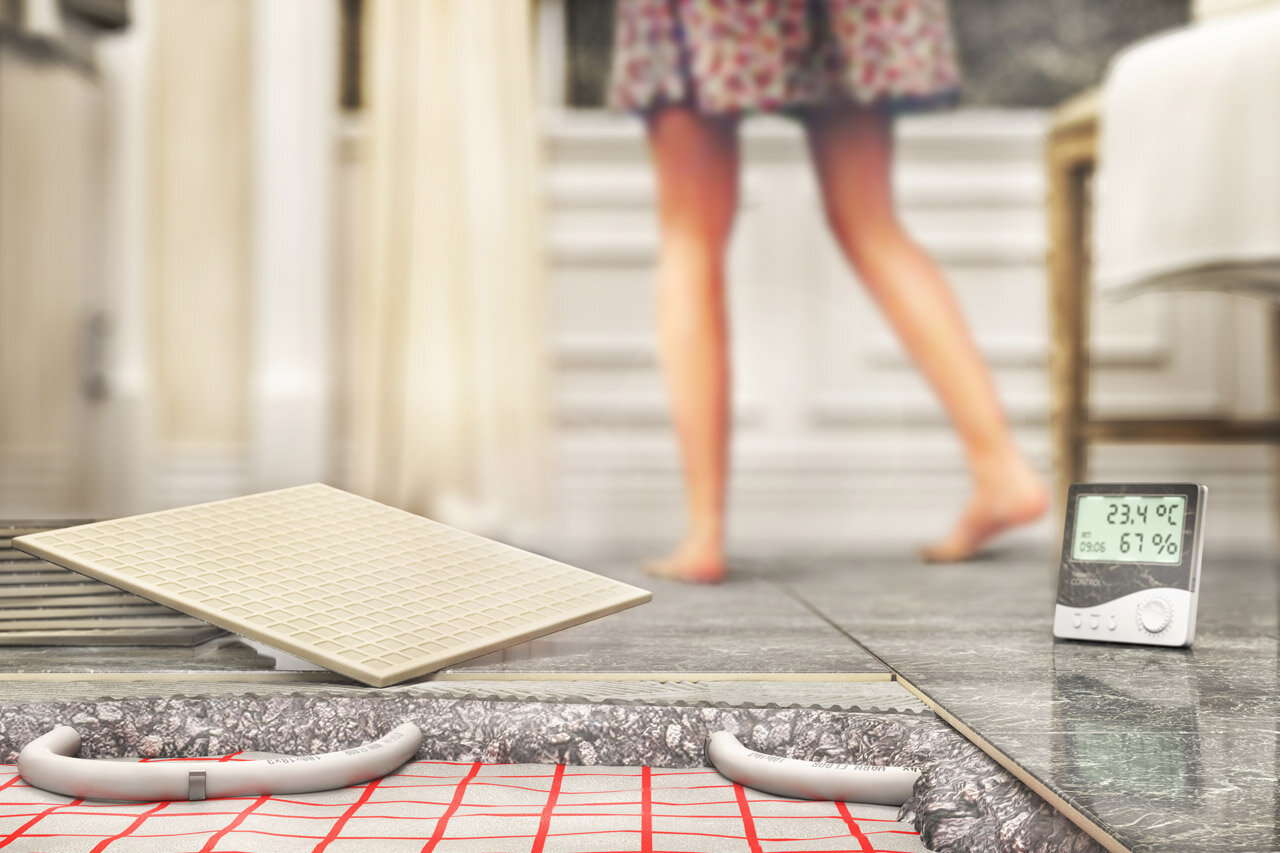Underfloor heating in the bathroom
10 December 2021

Underfloor heating - basic information
When looking at the temperature inside the house, in the bathroom it should be 4 degrees higher than in other rooms. With floor heating it would be easier to achieve, and it’s quite an economical solution, too. It is important to remember that the temperature at the floor level can’t exceed 34 degrees. This is the optimum temperature so that walking on the floor barefoot is comfortable and the towels can dry quickly. Depending on the investor's expectations, the floor heating in the bathroom can be either the main source of heat or a complement to the radiator. What is more, it can be made using different technologies as we can choose between water-based or electric heating. How do they differ and which variant is more popular?
Underfloor heating - water-based or electric?
The important thing is that no matter which option we choose, all the system components will be concealed under the floor. With water floor heating, polypropylene, cross-linked polyethylene or polybutylene pipes are laid. They are fixed to the floor at equal intervals and are laid in spiral-like loops. In the bathrooms, water underfloor heating pipes are laid every 5-10 cm. An unquestionable advantage is the low cost of both the installation itself and the subsequent use. The heating works together with the central heating equipment, the temperature is distributed evenly and the room is warm.
An alternative to water floor heating is electric heating. For this system, heating cables, heating foils and heating mats are used. In comparison to the previous option, the advantage of this technology is the possibility of installation in places where water installation isn’t possible at the moment, for example in houses that are already finished on construction level. They are also easily to install during bathroom renovations. Since the system is directly under the floor, the floor heats up very quickly once the heating is switched on. Besides, compared to water-based heating, the operating cost can be lower if the electric heating is on only when the room is in use. Thus, among the advantages are versatility, economy, but also low failure rate.
Plan your decor before you install floor heating
When deciding on underfloor heating, we need to think beforehand what the decor would be and where the shower or the bathtub, the washbasin and the toilet seat would be placed. The heating system should not run under any equipment. The loops should be laid in such a way that they are next to these appliances, but not under them. This is to prevent collision of the installation. Bathroom underfloor heating involves interference with the floor, so most often it is performed when the house is still under construction. Usually, electric heating may be a better option, which do not need many changes in house installations.
Advantages of underfloor heating
Based on the previous information, it is easy to see that floor heating in the bathroom has various advantages. In the first place, we notice the comfort of use, but it is not the only aspect which should induce us to opt for this solution. Although it’s more expensive to install underfloor heating than a radiator, at the same time it brings low operation costs. Warm air always goes up in the room. If we only have a radiator in the bathroom, the floor gets cold and we need to set a higher temperature. That is not a problem with the underfloor heating because the warmth can already be felt on the floor.
Another aspect that makes such an installation convenient to use is the possibility of precise temperature control. The heat does not escape under the ceiling and we can enjoy the temperature that we choose to apply. If we treat the underfloor heating as the main source of heat, we can save a lot of space in the room, the difference will be especially noticeable in small bathrooms.
After a bath or a shower, the bathroom becomes humid, the steam builds up on the walls and the floor, and towels need to be dried. Again, the underfloor heating is of help here since it makes the surfaces dry much faster. Therefore, it is a way to eliminate excess dampness. We shouldn’t forget about aesthetics either. The entire installation of the underfloor heating is concealed under the floor, so it doesn’t unbalance the decor in any way.
Disadvantages of underfloor heating
Although most people are satisfied with the floor heating, there are some skeptical voices, too. In most cases, this is either due to the myths that have arisen around this technology, or because of incorrect installation. Also, we should take into account higher initial investment cost, which has already been mentioned before. What's more, should any malfunction occur (which is very rare when it comes to installations done properly), the access to pipes and cables is difficult and it would be necessary to interfere with the floor.
What kind of floor for underfloor heating?
Another question arises in relation to the installation of floor heating: can it be used for any floor? Ceramic tiles are most commonly used in bathrooms, and in their case we do not have to worry that the heat coming from the installation will damage them. Besides, the tiles conduct the heat very well, so they are the right choice. Other materials, such as gres, terracotta, marble or granite are also suitable.
Dilemmas arise when it comes to wood or laminate flooring, which indeed may be an issue. Certainly, not every model is suitable. The material must be resistant to temperature fluctuations and humidity, and have a good coefficient of shrinkage. If the installation will be under the wood, then it must be suitable, like exotic wood, oak or acacia. However, floor heating shouldn’t be installed under the floor that is made of solid timber or a soft type of wood.